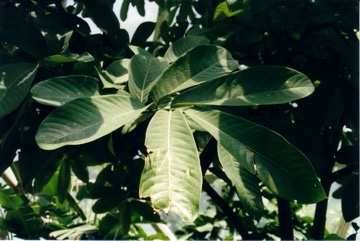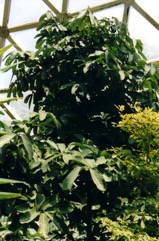Calabash nutmeg

A tropical plant. It grows naturally in West Africa. It grows in evergreen and deciduous forests. Trees grow well and flower in Indonesia but do not sett fruit. (The female flowers are ready to be pollinated before male flowers of the same plant are ready to produce pollen. Additional varieties are needed. ) In Brisbane Botanical Gardens.
Also known as:
African nutmeg, Airama, Ariwo, Awerewa, Bendo bendo, Calabar nutmeg, Calabash nutmeg, Djambadim-o, Duretche, Ehiri, Ehuru, Fausse noix muscade, Gipeve, Jamaican nutmeg, Lubushi, Mobe, Mpeya, Mukasa, Muscadier de calabash, Nding, Nuez enemeso, Muez moscada, Nzengo, Nzingo, Ophaningo, Peve, Quele-nai, Quele, Sambe
Synonyms
- Annona myristica Gaertn.
- Monodora grandiflora Bentham
- Xylopia undulata Pal. de Beauv.
Edible Portion
- Kernel, Spice, Nuts, Bark - tea, Seeds
Where does Calabash nutmeg grow?
Found in: Africa, Angola, Asia, Australia, Benin, Cameroon, Caribbean, Central Africa, Central African Republic, CAR, Central America, Congo DR, Congo R, Côte d'Ivoire, Cuba, East Africa, Equatorial-Guinea, Gabon, Ghana, Guinea, Guinée, Guinea-Bissau, Indonesia, Ivory Coast, Jamaica, Kenya, Liberia, Madagascar, Nigeria, Sao Tome and Principe, SE Asia, Sierra Leone, South America, Sri Lanka, Tanzania, Togo, Uganda, West Africa, West Indies
Status: They are for sale all over West Africa. They are exported to Europe.
Growing Calabash nutmeg
Cultivation: It can be grown from seeds, root cuttings, suckers or layers. Plants can be budded. Plants can be grown from stem cuttings. The seeds are extracted from ripe, dried fruit. They are soaked in water for 12 hours.
Edible Uses: The seeds are eaten and have a nutmeg flavour. The seeds are roasted and used for flavouring. They are used to flavour soups and other foods. The bark is cooked to make a tea drink.
Production: It grows at a moderate rate. In Liberia the nuts are produced from January to April. In Central African Republic plants flower in April.
Nutrition Info
per 100g edible portion| Edible Part | Energy (kcal) | Protein (g) | Iron (mg) | Vitamin A (ug) | Vitamin c (mg) | Zinc (mg) | % Water |
|---|---|---|---|---|---|---|---|
| - | - | - | - | - | - |
Calabash nutmeg Photos


References
Assogbadjo, A. E. et al, 2013, Specific Richness and Cultural Importance of Wild Edible Trees in Benin. Acta Hort. 979, ISHS 2013
Atato, A., et al, 2010, Diversity of Edible Wild Fruit Tree Species of Togo. Global Science Books.
Barwick, M., 2004, Tropical and Subtropical Trees. A Worldwide Encyclopedic Guide. Thames and Hudson p 280
Bodkin, F., 1991, Encyclopedia Botanica. Cornstalk publishing, p 707
Bouba, A. A., et al, 2012, Proximate Composition, Mineral and Vitamin Content of Some Wild Plants Used as Spices in Cameroon. Food and Nutrition Sciences 3:423-432
Bremness, L., 1994, Herbs. Collins Eyewitness Handbooks. Harper Collins. p 67
Burkill, H. M., 1985, The useful plants of west tropical Africa, Vol. 1. Kew.
Burkill, I.H., 1966, A Dictionary of the Economic Products of the Malay Peninsula. Ministry of Agriculture and Cooperatives, Kuala Lumpur, Malaysia. Vol 2 (I-Z) p 1515
Burubai, W., Akor, A.J., Igoni, A.H., and Puyate, Y.T., 2007, Some physical properties of African nutmeg (Monodora myristica), International Agrophysics, (21), pp. 123-124.
Dale, I. R. and Greenway, P. J., 1961, Kenya Trees and Shrubs. Nairobi. p 36
Dalziel, J. M., 1937, The Useful plants of west tropical Africa. Crown Agents for the Colonies London.
Davis, S.D., Heywood, V.H., & Hamilton, A.C. (eds), 1994, Centres of plant Diversity. WWF. Vol 1. p 172
Dibong, S. D., et al, 2011, Inventory and Biodiversity of species edible wild fruits sold in the markets of Douala, Cameroon. International Journal of Applied Biology and Pharmaceutical Technology. 2(3).
Facciola, S., 1998, Cornucopia 2: a Source Book of Edible Plants. Kampong Publications, p 14
Focho, D. A., et al, 2010, An ethnobotanical investigation of the annonaceae on Mount Cameroon. Journal of Medicinal Plants Research 4(20): 2148-2158
Hedrick, U.P., 1919, (Ed.), Sturtevant's edible plants of the world. p 418
Heywood, V.H., Brummitt, R.K., Culham, A., and Seberg, O. 2007, Flowering Plant Families of the World. Royal Botanical Gardens, Kew. p 33
Hoare A. L., 2007, The Use of Non-timber Forest Products in the Congo Basin. Constraints and Opportunities. Rainforest Foundation. p 18
Gallois, S., et al, 2020, Methodological priorities in assessing wild edible plant knowledge and use – a case study among the Baka in Cameroon.
Gohre, A., et al, 2016, Plants from disturbed savannah vegetation and their usage by Bakongo tribes in Uíge, Northern Angola. Journal of Ethnobiology and Ethnomedicine (2016) 12:42
Keay, R.W.J., 1989, Trees of Nigeria. Clarendon Press, Oxford. p 32
Latham, P & Mbuta, A., 2017, Useful Plants of Central Province, Democratic Republic of Congo. Volume 2. Salvation Army p 46
Lautenschläger, T., et al, 2018, First large-scale ethnobotanical survey in the province of Uíge, northern Angola. Journal of Ethnobiology and Ethnomedicine (2018) 14:51
Macmillan, H.F. (Revised Barlow, H.S., et al), 1991, Tropical Planting and Gardening. Sixth edition. Malayan Nature Society. Kuala Lumpur. p 382
Manvell, A., 2011, Use of Non-Timber Forest Products around Sapo National Park, Liberia (Report B) p 16
Menninger, E.A., 1977, Edible Nuts of the World. Horticultural Books. Florida p 82
Meregini, O. A., 2005, Some endangered plants producing edible fruits and seeds in Southeastern Nigeria. Fruits, Vol. 60 pp 211-220
Miguel, E., et al, 1989, A checklist of the cultivated plants of Cuba. Kulturpflanze 37. 1989, 211-357
Monog. Anonac. 80. 1817
Morley, B. & Everard, B., 1970, Wild Flowers of the World. Ebury press. Plate 50
Morton, 1976,
Nkeoua, G. & Boundzanga, G. C., 1999, Donnees sur les produits forestieres non ligneux en Republique du Congo. FAO. p 31
Ogu, G. I., Ekeanyanwu, R. C., Madagwu, E. C., Eboh, O. J. and Okoye, J., 2011, In Vitro Antimicrobial Evaluation of African Nutmeg (Monodora myristica) Seeds, International Journal of Tropical Agriculture and Food Systems, Vol 5, No 1.
Ogunmoyole, T., Inaboya, S., Makun, J. O., and Kade, I. J., 2013, Differential Antioxidant Properties of Ethanol and Water Soluble Phytochemicals of False Nutmeg (Monodora myristica) Seeds, International Journal of Biochemistry and Biotechnology, Vol. 2 (1), pp. 253-257.
Onyenibe, N. S., Fowokemi, K. T. and Emmanuel, O. B., 2015, African Nutmeg (Monodora Myristica) Lowers Cholesterol and Modulates Lipid Peroxidation in Experimentally Induced Hypercholesterolemic Male Wistar Rats, International Journal of Biomedical Science, Vol. 11 No. 2, pp. 86-87.
Peters, C. R., O'Brien, E. M., and Drummond, R.B., 1992, Edible Wild plants of Sub-saharan Africa. Kew. p 55
PROSEA handbook Volume 13 Spices. p 258
Raponda-Walker, A & Sillans, R., 1961, Les Plantes Utiles du Gabon. Editions Paul Lechevalier, Paris. p 69 (Drawing)
Sukarya, D. G., (Ed.) 2013, 3,500 Plant Species of the Botanic Gardens of Indonesia. LIPI p 403
Termote, C., et al, 2011, Eating from the wild: Turumbu, Mbole and Bali traditional knowledge of non-cultivated edible plants, District Tshopo, DRCongo, Gen Resourc Crop Evol. 58:585-618
Vivien, J., & Faure, J.J., 1996, Fruitiers Sauvages d'Afrique. Especes du Cameroun. CTA p 46
von Katja Rembold, 2011, Conservation status of the vascular plants in East African rain forests. Dissertation Universitat Koblenz-Landau p 173
World Checklist of Useful Plant Species 2020. Royal Botanic Gardens, Kew
Zapfack, L., et al, 2001, Ethnobotanical Survey of the Takamanda Forest Reserve. Consultancy Report PROFA, Cameroon. p 25